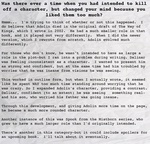Brandon Sanderson
Aonic
In the initial stages of Elantris‘ development, Aonic was one of the more difficult elements to construct. The Aons themselves—then still unnamed—were to become a major part of the novel. I wanted all of the Aonic names—including the names of two POV characters—to include references to the language. In addition, the magic system had complex connections with the Aons, influencing their actual forms and design. Furthermore, one of the greatest puzzles in the novel—that of Elantris‘ mysterious fall—was intimately tied to the power and shape of the Aons.
I began looking for sounds and themes. Usually, when I construct a language, I try to develop something with a few basic sound patterns that are easily recognizable. When a reader runs across a name in the book, I want them to be able to instantly determine which country that name came from. However, the names can’t be too similar, otherwise they will become a jumbled mess in the reader’s mind.
So I started, as I often do, with a couple of names. The first one I devised, I believe, was Raoden. The sound “Rao” (both vowels are pronounced in their long form) struck me. One of the things I wanted from Aonic was resonance with ancient classicism. I wanted the reader to reference a culture with a great, majestic history. Golden age Greece or imperial Rome—lands were gods were very real, and were thought to interfere with the workings of mortals. To the modern mind, these cultures bear a weight of age.
Rao. (Pronounced Ray-Oh). I liked the repeated long vowel sounds—they seemed to bear the weight I wanted. From there, I constructed other morphemes. Ene. Ashe. Dio. I started combining these, constructing a language that references modern Japanese with its combination of a natural tongue and imported Chinese characters.
The result was the Aonic language. Each name or word contained an Aon—a two-syllable morpheme that contained two log vowel sounds—and a non-Aon prefix or suffix. Raoden, for instance, contains the Aon ‘Rao’ with the non-Aon suffix ‘den.’ Seon contained the Aon ‘Seo’ with the suffix ‘n.’ The accent in these words is always placed on the Aon.
Then, like any good modern language, I was forced to bend a few rules. The name of the city was very important to the book, as I intended it to be in the title. I played around with several different words, including one that stayed through the entire rough draft of the novel—a word based on the Aon ‘Ado.’
In the end, however, I grew very partial to the word ‘Elantris.’ Again, this was for connotative reasons. It brought to mind ancient cultures without actually being too similar to any names I knew. The word seemed to have mythic import. Unfortunately, it didn’t contain an Aon. In the end, I went with it anyway. Any good language has sound-changes and broken rules. Elantris, therefore, is based off of the Aon ‘Ela,’ which is a very Aonic sound. When combined with its suffix, however, the secondary vowel is weakened—though not completely. When I say the word in my head, the ‘a’ sound is stronger than it probably is to most readers.
The second bent rule references Sarene’s name. Originally, her Aon was ‘Ana,’ with two long ‘a’ sounds. Unfortunately, ana looked too similar to the word ‘anal’ to me. Eventually, I changed her from Sarana to Sarene. Still, in my head, I pronounce this word ‘Sar-Aynay,’ though the Aonic usage of the name would be more appropriately rendered ‘Sar-eenee.’
With the Aonic language finished, I could easily fill in the names of side-characters and places. I threw out a few sounds—there is no ‘u’ sound or ‘th’ sound in Aonic—and from there could construct hundreds of names from Aonic combinations of sounds. I designed a few of the characters for referencing in the book, and the language grew from there.

